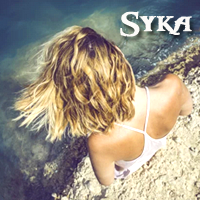All flora and fauna development for Kenash goes within here. If you have a submission in the Suggestion Box, please move it to this thread to get added to Kenash's main forum
(This is a thread from Mizahar's fantasy
roleplay forums. Why don't you
register today? This message is not shown when you are logged in. Come roleplay with us, it's fun!)
This forum is Kenash's development forum. Please feel free to post your ideas and suggestions as well as join in any discussions that are currently ongoing.
Moderator: Gossamer
 by Tinnok on May 12th, 2013, 10:36 pm
by Tinnok on May 12th, 2013, 10:36 pm
Granidile (Grahn-eh-dial)
Size: Males and females tend to be of similar sizes, generally measuring at 25 feet from snout to tail, though females are generally bulkier, weighing in at 500 - 600 lbs out of water while the males are generally more agile at 400 - 500 lbs
Color: Ranges from dark greys to vibrant forest greens, with varying shades of brown not uncommon.
Location: Waterways of Kenash
Lifespan: Granidiles can live up to 40 years of age.
General Information: The Granidile is the main aquatic predator of Kenash. One thing all of these reptiles share, however, is the hard as granite armor coating that adds a significant addition to their weight, as well as their durability. It is quite rare to find these creatures very far on land, for it takes a great deal of effort for them to move themselves out of the water.
While virtually useless save for their powerful jaws on land, Granidiles are apex predators in the waters of Kenash. The only way to kill one is to expose and cut open their soft fleshy stomach, so tough is Granidile hide. And it takes a brave or very desperate soul to enter waters filled with Granidile.
Granidiles are solitary creatures, preferring to hunt alone as they have few natural predators, and have no need of numbers. They group up for mating rituals, and can be found in relatively large numbers sunning themselves while partially submerged, however, perhaps a defensive technique due to their exposed nature. Granidile females can lay a clutch of up to 100 eggs, usually deposited in early summer to hatch before fall. Due their incredible bulk, and the fact that this is generally the only time a Granidile emerges from the water fully, more than one slave has discovered a beached female that has starved, unable to drag its bulk back into the water. Occasionally this results in the young eating the remains of their own mother depending on the amount of meat remaining upon the carcass once they have hatched.
Value: Young granidiles are often traded in the same manner of slaves, and just as often bought with goods as money. You are likely to pay a minimum of 50 GM for a single infant, however, for while they are a finicky creature to train, their presence as a guard on a plantation can be more than worth the risk.
The leather of a Granidile is just as valuable as from any other crocodile, but the armored sections that coat their back can sell for 50 GM per square foot, so effective of an armor is it. It takes a skilled crafts-person to properly shape and fashion Granidile armor into clothing, but it is a worth while investment for any Dynasty that wishes to have the best outfitted guards.
|
|
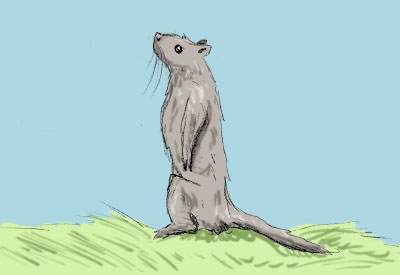
Size: 2-3 feet in length 25-20 lbs
Color: Dull brown to silvery grey fur
Location: Kenash
Lifespan: 4-6 years
General Information: Krite are a small group of aquatic weasels closely related to the otter. Quick, intelligent, and omnivorous, these creatures are largely considered pests by the dynasties around Kenash for their penchant of getting into any and all crops and gathering from plantations at their leisure. They have webbing in between their toes, and a powerful tail that they use as a rudder when swimming. Agile on land and in the water, it is said that they are one of the only species who can comfortably traverse the water ways of Kenash swiftly enough to only casually worry about granidiles.
Krite generally live in colonies dug into the banks of Kenash, and live in groups of about a dozen. They have a complex family system, and raise their young communally. Certain Krite perform different tasks, and it has been found that some of the agile Krite seem to have no other purpose than distracting under water predators when their pod has need of travel.
Social creatures Krite have a tendency to be very curious and friendly, which can lead them to be fairly easy prey, and extremely good pets. The Draer Dynasty especially seems keen to utilize these potential vermin instead of dismiss and kill them, and it is rumored that they were responsible for teaching the creatures to steal from plantations in the first place. Krite pelts can be sold for 1 GM per pelt, for their fur has useful waterproofing properties for clothing.
Value: While rare due to their frequency Krite can be bought and sold for 1 SM. |
|
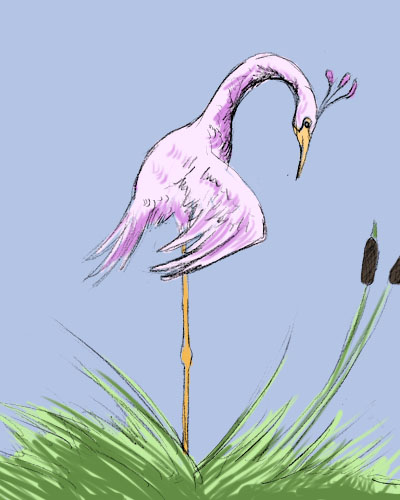
Size: Pygulls generally weigh around 20 Lbs, and can reach up to 7 feet in height.
Color: Light pinks with white tipped feathers to deep fuchsia and violet coloring depending on health and location.
Location: Kenash Swamplands
Lifespan: 4 -7 years
General Information: Pygulls are one of the more popular sights in Kenash for their vibrant coloring. Feathers can range from a dull light pink to vibrant magenta and violet depending on location and diet of the Pygull. Tall birds, they are quite small and light, and not jokingly, all leg. They feed upon insects and small fish, and are patient predators, often remaining in the same position for days if they are given no cause to move. Calm and serene these birds speak of a side of Kenash rarely seen by the passerby or inhabitant. While not particularly useful other than for show, Pygulls can be used as a basic form of pest control on plantations.
Pygulls like to flock together, but are not particularly social birds. They gather for elaborate mating ceremonies, and a male and female stick together through the egg laying and hatching process, but the male leaves shortly after the infants are born to pursue other activities, and the mother abandons her young before they are able to gain flight, a strange ritual which leaves the population of Pygulls relatively low.
There is a silent competition between the dynasties, almost all of which house and keep Pygull's in some fashion or another, to see which plantation can sport the most beautiful stock of the long legged bird. It is extremely bad luck to kill a Pygull, though their feathers do adorn the collars and dresses of many an outfit in Kenash, but even the slightest rumor that the Pygull was killed before its time can ruin an entire wardrobe, so only the boldest of families generally risk wearing the flamboyant feathers.
Value: Pygulls are bred and sold in markets around for Kenash, depending on the lineage of the family, generally based on coloring and temperament, a Pygull can range in price from 10 gm up to 75 gm.
|
|
-

Tinnok - A Witch of the Wilds
-
- Posts: 888
- Words: 878542
- Joined roleplay: February 3rd, 2013, 5:27 pm
- Race: Mixed blood
- Character sheet
- Storyteller secrets
- Journal
- Medals: 2
-


 by Spirit Frostfawn on May 12th, 2013, 10:47 pm
by Spirit Frostfawn on May 12th, 2013, 10:47 pm
 Thin nose minnow Thin nose minnow
Size: Tiny (1/2 an inch long)
Color: Murky brown
Location: Most watery areas of Kenash, mainly the rivers
Lifespan: Two years
General Information:Thin nosed minnows are the primary food source for most small predators. Gathering in massive schools of at least 100, these inch-long fish are easy to find. However, their quick speed, darting movements, and ease of hiding make it hard to catch them in any way other than a surprise attack. Unlike most minnows, this species it is practically flat, for ease of darting through the reeds of the swamp. Their brownish scales do provide slight camouflage in the swampy water, but their large gatherings generally make them quite obvious to the casual observer.
Being so small and narrow, the thin nose is hard to catch with most ordinary nets. However, it’s quite simple to get and make one with holes so small that they can’t slip through the weave. Using this tool, they can be captured in large numbers, which is good since their meat is particularly tender and delicious. It’s not rare to see young children raising a few of these fish as pets, but it usually ends in despair when they die, since their lifespan is a mere 2 years long.
Value: 1gm/lb |
 Sokki Cat Sokki Cat
Size: 1 foot high, 2 feet long
Color: Brownish green patches
Location: Edges of the rivers
Lifespan: 15 years
General Information: Compared to most wild cats, the Sokki Cat is relatively small. Only slightly bigger than a house cat, it has several other major distinguishing features. Its paws are wide, and actually slightly webbed, for ease of swimming and fishing. It’s tail is wide and bushy, and when the animal stalks whatever prey it is following, the appendage always sticks straight up. However, this isn’t really much of a disadvantage, since the tail is quite short, and looks almost exactly like a stick. The feline’s fur is also brown and murky, with the occasional patch of green for camouflage. Also unlike most cats, the Sokki swims quite a lot, and will generally make its home on a branch overhanging water.
Since their pelts are quite rough and patchy, and their meat bitter and stringy, these cats are rarely hunted. Instead, some are occasionally kept as pets, though the lack of soft fur turns off most potential owners. So, in the eyes of most sentient creatures, the Sokki Cat is seen to be relatively useless, and are most often ignored. Encounters between the residents of Kenash and this feline are rare, but generally uneventful.
Value: 3gm for a carcass. 15gm for a pet. |
|
-

Spirit Frostfawn - Whistle with the Birds
-
- Posts: 432
- Words: 302388
- Joined roleplay: March 23rd, 2013, 11:53 pm
- Location: Avanthal
- Race: Human, Vantha
- Character sheet
- Storyteller secrets
- Scrapbook
- Plotnotes
- Medals: 1
-

 by Tia'aria on May 14th, 2013, 12:56 am
by Tia'aria on May 14th, 2013, 12:56 am
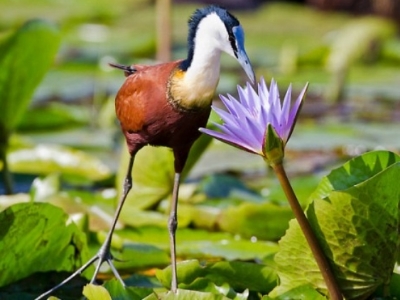 Borodos Duck Borodos Duck
Size: Four feet tall, female is generally wider than the male.
Color: Males: Midnight blue crown and spine from head to shoulders, white throat and face, russet bodies. Females: Brown heads and necks, midnight blue crown.
Location: Rivers and waterways.
Lifespan: Five years in the wild, eight when domesticated.
General Information: The Borodos Duck isn't actually a duck, but more of a heron. However, the early inhabitants of Kenash that first discovered the Borodos truly believed that it was built exactly like a duck for the way it floated upon the water and christened it the name it carries today. In truth, Borodos Ducks don't swim, but walk along the bottom of shallow rivers and give the illusion of swimming. Their feet are unique in the fact of the spindly length of their toes and legs, which make up more than half their body size, that gives them the added ability of being dextrous in the water. However, they are not able to fly and are generally heavily preyed upon by swamp predators. Therefore, Kenash's residents have taken to domesticating them for their eggs and meat, which is quite succulent.
Value:Unfertilised Eggs: 5 gm Chicks: 1 gm Adults: 8 gm |
|
-

Tia'aria - shut up + trust this.
-
- Posts: 141
- Words: 60906
- Joined roleplay: August 3rd, 2012, 7:27 am
- Race: Konti
- Character sheet
- Storyteller secrets
- Plotnotes
- Medals: 1
-

 by Tinnok on June 5th, 2013, 1:41 pm
by Tinnok on June 5th, 2013, 1:41 pm
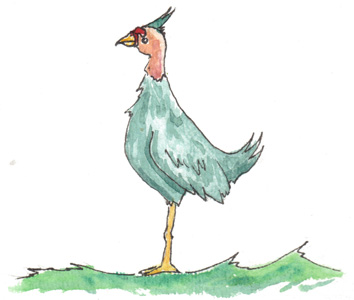
Size: 2 feet tall
Color: Bright pink/ orange skin with flaming waddles, teal/ turquoise down and feathers.
Location: All over Kenash
Lifespan: 4-6 Years
General Information:
Skritchers are the chickens of Kenash, sociable and talkative birds that generally lay an egg or two per day during their prime. Their eggs are a coppery color and medium sized.
Skritchers in inhabited the swamps of Kenash long before any sentient being stepped foot in its lush waters, surviving off insects, algae, and other aquatic plant life in the daytime, nesting in trees at night to avoid the many ground bound dangers lurking in the waterways and thickly covered areas of Kenash. Found to be easily tamed upon settling, early Kenash families used the Skritcher just as much for food as bait for other larger animals. It is not uncommon to find fat Skritchers bred around the city for the sole purpose of drawing out Granidiles, who seem unable to resist the small meaty bird.
Social creatures, Skritchers tend to flock together, even in the wild, and generally a pair of roosters provide over a flock. While Skritchers are not intelligent birds, they can be trained from an early age basic tricks, and the chicks are often seen following young dynasty members around until the child tires of them.
Value: A good laying hen can be sold for 1 SM, roosters are generally sold for 5 CM. The Turquoise feathers can be bought at 7 SM/ LB. |
|
-

Tinnok - A Witch of the Wilds
-
- Posts: 888
- Words: 878542
- Joined roleplay: February 3rd, 2013, 5:27 pm
- Race: Mixed blood
- Character sheet
- Storyteller secrets
- Journal
- Medals: 2
-


 by Tinnok on June 5th, 2013, 2:06 pm
by Tinnok on June 5th, 2013, 2:06 pm
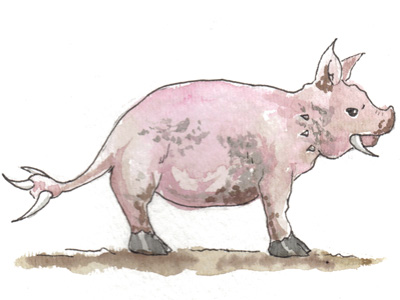
Size:Shires are short and squat pigs, usually only a few feet high and weighing up from 50 - 80 lbs.
Color: Shires range in coloring from light browns to dull pinks. All of the breed has a strange greenish sheen to their skin, however.
Location: Kenash fields and low vegetated areas
Lifespan: 6- 10 years
General Information: Coveted by the Ackina Dynasty, Kenashires are a product of the Djed Storm of 512 on the large troop of a particular breed of pot bellied pigs they kept upon their ranch. The piglets born in the following litters that Spring were strangely reptilian in nature, and grew up quite larger than their parents, supplying more meet and growing sizable tusks. Spring of 513 has shown the first successful litter of Kenashires, the first breed of pig to be uniquely found in Kenash.
Bred for meat most of the pigs on the Ackina ranches mature swiftly and are put to the knife at an early age. While the Kenashires seem to mature quickly, Ackina has been hesitant to send them to the butchers as swiftly, as the tusks and tail that the swine develops is a helpful tool in furrowing the soil for new plantings. The meat of these pigs has been tested and approved by more than one dynasty, and thus the uses of this new breed of pig seems to be wide ranging.
Currently, Kenashire piglets are a must for any young child looking for a unique pet, and it is said the intelligence level of the pigs is quite admirable.
Value: Kenashire piglets are quite priceless, and are only received after deal making with the Ackina Dynasty. The pigs meat is currently going for 5 GM/ LB in the Bloody Butcher shop in town.
|
|
-

Tinnok - A Witch of the Wilds
-
- Posts: 888
- Words: 878542
- Joined roleplay: February 3rd, 2013, 5:27 pm
- Race: Mixed blood
- Character sheet
- Storyteller secrets
- Journal
- Medals: 2
-


 by Tinnok on June 5th, 2013, 2:18 pm
by Tinnok on June 5th, 2013, 2:18 pm
Trimeon (Trehm-ee-ohn)
Size: Four feet long including tail, generally a foot and a half to two feet in height, weighing no more than 7 or 8 lbs.
Color: Light tan to bright yellow coats with black splotches.
Location: In and around the plantations of Kenash
Lifespan: 11- 15 years
General Information: Trimeons were a breed of desert cat from Ekytol, brought to Kenash after a picture of of one sent some Dynasty brat on a tear of wanting the creature for themselves.
It is rumored that only a dozen of the creatures were brought over, but now hundreds, perhaps even thousands inhabit the land around the plantations of Kenash. Trimeons are not suited for the wet wilderness surrounding the city, and so when they are not lap pets of the wealthy and fed dishes of milk and dried fish behind the plantation houses, they have become scavengers. One of the only creatures that is commonly a pet of both Dynasties and slaves alike (if it can be said that slaves ever have pets), the Trimeon's that are supported by wealth are noticeable by their vibrant coats and the quality of their ears, a very important trait when selling kittens and setting up potential breeding opportunities.
Affectionate and dainty felines, Trimeons can be quite lovely companions to any that give them care.
Value: Trimeon kittens are generally bought for 10 GM (good breeding stock) apiece and their fur is usually 10 GM/foot when high quality.
Regular scavenger Trimeon pelts are generally sold for a couple SM a piece.
|
|
-

Tinnok - A Witch of the Wilds
-
- Posts: 888
- Words: 878542
- Joined roleplay: February 3rd, 2013, 5:27 pm
- Race: Mixed blood
- Character sheet
- Storyteller secrets
- Journal
- Medals: 2
-


 by Khida on June 22nd, 2013, 12:34 am
by Khida on June 22nd, 2013, 12:34 am
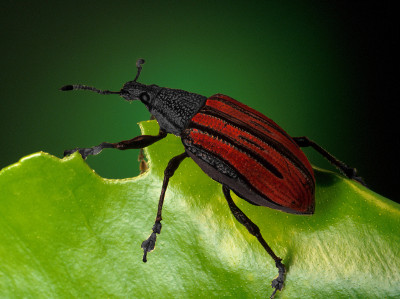
Gloom Beetle
Size: 0.25 inch
Color: red and grayish-black
Location: tobacco fields; occasionally seen among other crops or in gardens
Lifespan: 3-5 weeks, unless dormant
General Information: Gloom beetles are named not only for their gray-black base color, but for the mood which often descends upon slaves and overseers who spot them. They feed primarily on tobacco plants, and where there is one gloom beetle, there are probably many, many more. Infestations can be controlled in good years, but are nigh impossible to eradicate completely.
Adult beetles begin emerging from dormancy as the weather warms, becoming abundant in middle to late spring. Adults feed on lower leaves, leaving circular holes in the edges; they can kill young plants, particularly early in the year, but generally do only minor damage to older plants. Eggs are laid inside plant stems, where they remain invisible and unnoticed. Larvae feed primarily on leaf buds, flower buds, and on younger leaves, progressively denuding the plant from top down until they pupate. After about 7-10 days, the larvae retreat into cocoons, emerging as adults around 10-15 days later. The new adults go on to lay more eggs, repeating the cycle. Most years see five to seven generations from spring into fall, but up to ten successive generations can occur during particularly permissive years.
In an average year, gloom beetles can do substantial damage to tobacco crops, but are a manageable nuisance. However, these beetles are known to swarm, occurring in dread-inducing abundance throughout unlucky seasons. It's not known what differentiates a swarm year from a normal year, aside from the fact of vastly many itty-bitty red-and-black beetles crawling all over the fields. When swarming, gloom beetles can severely devastate tobacco crops. They are even known to try and feed on plants other than tobacco -- probably on account of overcrowding. Although the beetles don't seem to survive well on any other food, they still cause some damage to those crops and concomitant loss of value. Nonetheless, it's tobacco profits which a gloom beetle swarm endangers most; fortunes small and large can be lost to their hungry mouths.
Value: None, unless a bounty is offered for clearing them out. |
-

Khida - Player
-
- Posts: 1020
- Words: 574944
- Joined roleplay: April 14th, 2012, 11:14 pm
- Location: Endrykas
- Race: Kelvic
- Character sheet
- Storyteller secrets
- Scrapbook
- Plotnotes
- Medals: 4
-


-


 by Tinnok on July 23rd, 2013, 8:45 pm
by Tinnok on July 23rd, 2013, 8:45 pm
Octobeetle
Size: Half and inch long, not including the multiple antennae which can triple the beetle's length.
Color: Their hues range from vibrant aquamarine to a brilliant emerald sheen.
Location: Thickets and scrub land around Kenash
Lifespan: 1 year (Optimistic)
General Information:
The Octobeetle, named for the numerous antennae that sprout from its forehead is a small and vibrantly hued insect valued for its surprisingly durable shell that is often used in jewelry and other adornments. The delicate fronds sprouting from its head are also valued for use in very delicate creations, and are said to act like a strand of the finest silk. Though lovely, it is hard to harvest enough of these fine strands to provide of much use, so the most common appearances of it are usually in earrings and woven bracelets.
This particular breed of beetle is an uncommon sight, generally because of the frequency of its parts being harvested, generally before the octobeetle has had a chance to procreate and lay its hundreds of eggs in a cool warm spot near the edges of the swamp. Because of their rarity in Kenash proper it is extremely good luck to find one perched upon a building or upon a plantation, and speaks of a good omen to the finder.
Value: A collection of a dozen octobeetle shells can sell for 10 GM. The antennae are more valuable, but difficult to collect in large enough quantities for anyone to buy them off of a prospective seller. It is said that slaves spend their lives in search for the silky strands in hopes that someday they will have enough to sell and buy their own freedom. How quaint.
|
|
-

Tinnok - A Witch of the Wilds
-
- Posts: 888
- Words: 878542
- Joined roleplay: February 3rd, 2013, 5:27 pm
- Race: Mixed blood
- Character sheet
- Storyteller secrets
- Journal
- Medals: 2
-


 by Tinnok on August 21st, 2013, 5:52 pm
by Tinnok on August 21st, 2013, 5:52 pm
Ponda Bear
Size: Up to four feet in length and weighing up to 120 lbs, females usually running a little lighter.
Color: White pelts are broken up by aquamarine splotches that vary in hue depending on age from bear to bear.
Location: Bamboo forests of Kenash
Lifespan: 10 - 15 years
General Information: 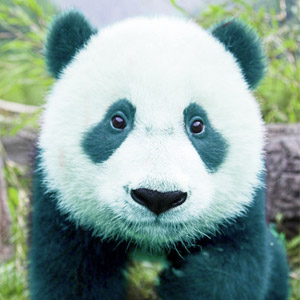
The Ponda Bear is native to the thick bamboo forests that pop up around the wet scrub lands of Kenash, spending most of their lives ensconced among their favorite food. Several plantations keep Ponda Bears on the grounds in captivity, they are rarely hunted, for although their pelts can be used for clothing and leather, their meat is unusually tasteless and tends to spoil quickly, so instead Ponda Bears are more often caught than killed, and sometimes trained for the amusement of Plantation families.
Their natural predators are Granidiles, who seem not to mind the taste of the slow moving bears, but it is rare to see one of these creatures attempting to cross the water ways of Kenash.
Their pelts are worth 10 GM, and cubs are often sold for 50 GM and higher as pets.
|
|
-

Tinnok - A Witch of the Wilds
-
- Posts: 888
- Words: 878542
- Joined roleplay: February 3rd, 2013, 5:27 pm
- Race: Mixed blood
- Character sheet
- Storyteller secrets
- Journal
- Medals: 2
-


Users browsing this forum: No registered users and 0 guests
